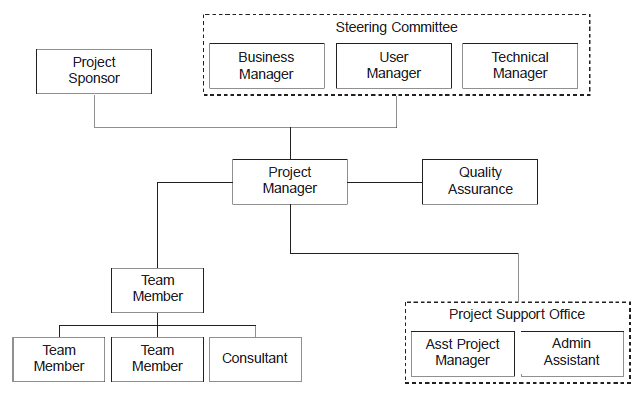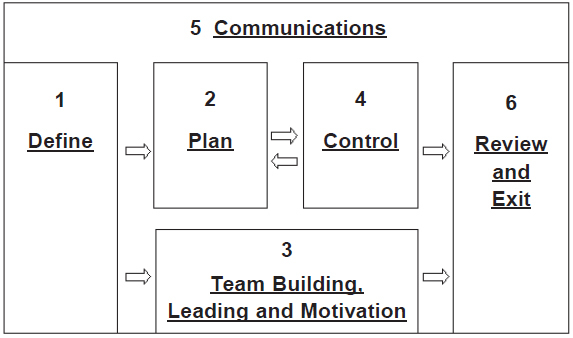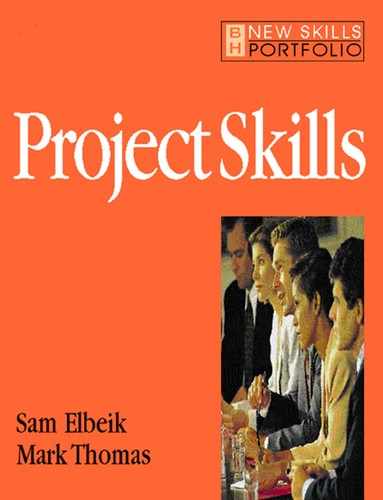1 |
Real-world project |
Why is this book different?
The subject of project management has developed over the years into a fairly precise set of techniques, definitions and practices that are applicable to running projects. Full-time project managers with a number of years of experience understand these practices and endeavour to apply them when managing their projects. Unfortunately, many projects are managed by people who have been thrust into the project management role as well as continuing with their day-to-day activities. After being sent on a project management course by their organization, the expectation is that they can deliver the project objectives with their newly gained knowledge. It is not surprising that several recent surveys conclude that up to 80 per cent of projects are delivered late and are over budget.
The secret to successful project management practice is knowing when to apply the appropriate technique at the right stage in a project. The Project Management Institute Standards Committee, USA, identify this by saying:
 |
The knowledge and practices (of project management) ... are applicable to most projects most of the time ... [it] does not mean that the knowledge and practices described are or should be applied uniformly on all projects. (Project Management Institute Standards Committee, A Guide to the Project Management Body of Knowledge) |
All too often for the first few times when someone is asked to manage a project they will try to apply all the techniques they have been taught, thinking that if a particular technique is omitted, the project will fail. They soon find out that they do not have the time to apply all the techniques and begin to drop one after the other.
 |
This book describes accepted project management techniques, but we have selected only the most essential techniques, which takes the guesswork out of deciding which ones to apply at which stage. It also presents ‘people’ skills essential to making a project succeed. These skills include team-building, leadership and motivating others to deliver. |
People make the project team
 |
Try not to lose your head, even when all around you seem to be losing theirs. Stay calm. Try anyway – then if you need to shout, go and have a good scream in a room on your own! (Dalim Basu, Project Manager, ITN) |
All projects need a number of different people to make them happen, and to make them succeed. This book is aimed primarily at the person who has to manage the project, although all practising managers will benefit from the fundamental techniques that are presented.
Simply understanding the need for the involvement of a number of groups (Figure 1.1) is in itself a benefit in making a project succeed.
Project managers
New project managers who have not experienced the development of a project, as well as seasoned project managers, will benefit from the techniques described in this book. One of the main lessons to emerge is that project management is not about using the latest software to produce impressive-looking charts that are displayed on a wall for all to see at the office. Rather, it is more about understanding and using the variety of tools and techniques that are available. Indeed, many of these only require minimal use of computers. The critical skill is focusing people’s thoughts on to a problem in a structured way.

Figure 1.1 Who does the project manager deal with?
Most project managers are traditionally taught to develop a detailed project plan of all the activities needed to complete the project. This approach is not always appropriate in a world where rapid changes in technology can significantly change the details of a plan. In most cases, only an outline plan is required of the main project activities, followed by the traditional detail of the first-stage activities. Understanding this critical point can save many hours of needless effort in initially recording all the activities involved, only to have to change them a few weeks later.
Sponsors of projects
One of the biggest problems for sponsors of projects is to visualize the whole picture when it comes to commissioning a project. Understanding all the different elements necessary to successfully implement a project is a challenging task, and recognizing the need for each of these elements will give them a head start.
Have the objectives been agreed with the team? How often will feedback on progress be given? Have all the appropriate departments been involved from the start? Should internal or external people resources be used? The questions are almost endless, but the answers contribute to making up the bigger picture. This book will provide a framework that any project sponsor can use to ensure that all elements of a successful project actually happen.
The team
For a project to succeed the team should recognize the need for project management; what it means and what their contribution does for the project. The team needs to understand the key stages of managing a project and the impact of their work on the whole project. Individuals make up a team and recognizing the efforts of the project manager in building, leading and motivating the team is vital to the success of the project.
Functional experts and advisers
Functional experts such as members of a Human Resource Department, Finance Department or Marketing Department often participate in projects because they are the recipients of a system or process, or their areas provide the rules for developing systems or processes. But such people cannot act in isolation. Participating fully at the beginning as well as during the life of a project is critical for it to succeed. Understanding the roles of other participants as well as their own role contributes to eventual success. A project that progresses without regular checks, or feedback, from such functional experts during development often results in failure.
Leading and motivating the team
Understanding what motivates people will help us explain and manage their behaviour, thus allowing the team leader to get the most out of team members. Any project manager is expected to have team-leading qualities and be capable of motivating other people.
 |
Understanding that a wide variety of people contribute to the project team, from the sponsor to the functional expert, is an essential element in successful project management. Time and effort must therefore be spent on understanding what motivates each person or group. In turn, appropriate management action must follow. |
The project manager who is a team leader must strike a balance between implementing the tools and techniques as well as applying appropriate people management skills. Asking a science technician to keep to strict time schedules when analysing blood samples may be necessary to keep a bio-research project within budget, but providing a clear sense of direction by reminding the technician of the end goals is vital.
Project team structures
There are a number of ways organizations are structured to cope with day-to-day business. Classical structures include hierarchical, product and matrix and in many cases, a single organization may well have a mixture of these structures. Modern communication facilities such as video conferencing and the Internet have also made possible the virtual organization.
 |
The essence of a project team is that it brings together individuals from within an organization and from external suppliers who are highly focused on completing project deliverables to support a project objective. |
Functional organizations
The functional organization (Figure 1.2) is characterized by a rigid structure of reporting lines and is often described as a pyramid, with power residing at the top of the pyramid. The executive at the top of such organizations, the chief executive officer (CEO), will have a number of managers reporting to him or her. These managers will typically head departments or functions such as Information Technology (IT or IS), Human Resource (HR), Marketing, Production, Finance, and Research and Development (R&D).

Figure 1.2 The functional organization
Projects are carried out in each department where most of the project team comprises individuals from within the department. A number of functional experts from other departments will also work on the project, but they will work from within their own departments and are usually physically separated from the majority of the project team. There will be a project leader, again coming from within the department, who would report to the head of department.
Advantages
- The majority of the functional specialists easily share their knowledge because they come from the same department and normally work together.
- It is easier to implement work rules and regulations for a group of similar functional experts.
- They will also share a commonality of perspective that will help the main thrust of a project.
Disadvantages
- Responses to change in market conditions are usually slow. These take time to implement because requests for approval have to be sought through several functional management chains.
- Communicating and co-ordinating the team is difficult because team members are split across several functional departments within the organization.
- Rivalries and conflicts may result.
Product organizations
The product organization (Figure 1.3) arranges its functional experts within teams that work towards delivering a new product. Much of the authority for approval rests with the product manager and so there is a shorter chain of command to the overall organization manager.

Figure 1.3 The product organization
Advantages
- Reaction to market changes is rapid as authority exists in the project team.
- All team members, who are functional specialists work for the same project leader.
Disadvantages
- Duplication of functional experts will exist across the organization as they are each dedicated to a single project.
- There is a lack of information exchange between functional experts as they are located in different parts of the organization.
Matrix organizations
The matrix-based organization (Figure 1.4) is characterized by having a pool of project managers who will be assigned to projects as they are commissioned. The functional experts are provided by departmental line managers until the project ends. The experts then return to their respective departments and report to their line managers.

Figure 1.4 The matrix organization
Advantages
- Response to changing project needs is very rapid.
- Functional experts are more part of a team and are more focused on project deliverables.
- Team members have a functional department to return to after the project.
- Their respective departments look after their careers and specific development needs.
Disadvantages
- There can be conflict between functional line managers and project managers over the deployment of resource.
- If the team is not physically located in the same area in a building, communications and control becomes a difficulty.
- Matrix structures are frequently hindered by accusations of poor accountability and lack of clarity in responsibilities.
Virtual organizations
Virtual organizations (Figure 1.5) are real and are here today. These organizations usually have a small physical presence, typically a head office, and the functional experts work from client locations or their homes. They rarely travel to the organization’s offices and rely heavily on personal computers and communication devices such as telephone, fax, e-mail and video conferencing.
Advantages
- The organization maintains reduced financial overheads, as there is no requirement to maintain office space for all employees.
- Procedural standards must be enforced to maintain quality and control of project deliverables, as team members do not work at a single location.

Figure 1.5 The virtual organization
Disadvantages
- More effort must be put into motivating the individual team members because they tend to work in isolation and lose social contact with other members of the team.
Small project structures
Irrespective of how an organization structures its projects, it is generally accepted that every project must have, as a minimum, a project sponsor and a project manager. The sponsor commissions the project and the project manager defines, plans and controls the project as well as carrying out the actual tasks. There is a danger that, even on a small project, the project manager spends most of his or her time on the actual tasks, and does not spend enough time on managing the project. Typical consequences of this are that the project end date slips, or the quality of the deliverables is compromised.

Figure 1.6 Project structure for smaller projects
A project manager running a small project must continually assess whether he or she has the time to carry out the project tasks as well as manage the project. Quite often some of the work can be delegated to other people, or experts, in the organization, giving the project manager more time to manage the project. These experts need to be managed and, although they do not formally report to the project manager from an organizational point of view, they are part of the project team and are responsible for working on project tasks.
A typical project structure for smaller projects is shown inFigure 1.6.
Larger project structures
On larger projects, the number of people involved can increase significantly.Figure 1.7 shows the various relationships, roles and structure.
Roles and responsibilities
On reviewing the previous sections, it is clear that a variety of skilled people are involved in running projects. We have looked at different organizational structures and at small and large project structures.

Figure 1.7 Project structure for larger projects
We now summarize the roles and responsibilities of the people involved in delivering a project.
Project sponsor
- Commissions and owns the project.
- Is clear about the objectives and scope.
- Finds and wins resource(s) for the project.
- Chairs the steering committee.
- Is enthusiastic about the project.
- Represents the first-line issue resolution for the project manager.
Steering committee
- Project sponsor creates the steering committee.
- Has representatives from business and technical functions and user community.
- Reviews overall project direction, schedule, costs and quality of deliverables.
- Resolves major issues/problems.
- Sponsor chairs the steering committee.
- Project manager attends steering committee meetings.
- Typically meets every few weeks.
Project manager
- Manages the project, the people and paperwork.
- Responsible for achieving project objectives within scope, time
and budget. - Prepares the Terms of Reference, and plans the baseline.
- Evaluates risk and prepares contingency.
- Controls the project and implements the plan.
- Builds, leads and motivates the team.
- Reviews and replans.
- Maintains good communications with team and all stakeholders.
- Makes regular presentations.
- Tackles problem areas sooner rather than later.
- Manages sponsor expectations.
Team member
- Technical expert qualified to complete project tasks.
- Gives regular feedback on progress to project manager.
- Focuses on delivering quality.
- Contributes to teamwork and moral.
Project support office
- Created on large projects.
- Provides administrative support to project manager and team.
- Collects time sheets.
- Prepares progress reports and meeting minutes.
- Updates project plan with tracking information.
- Responsible for project accounting.
Quality assurance
- Carries out project quality reviews.
- Is not part of the project team.
- Is an independent person giving unbiased opinions.
Essential project activities
This introduction focuses on two key points:
1 People, and teams, make a project succeed
2 The essential project stages.
 |
The critical things that are needed to run a successful projects are: |
| |
| Manager, Microsoft) |
In summary, a project can be divided into six distinct stages. These make up the classic project management model (Figure 1.8):
1 Define.
2 Plan.
3 Team-building, leading and motivation.
4 Control.
5 Communications.
6 Review.

Figure 1.8 Classic six-stage project management model
In the define stage, the project manager prepares a document that records the essential client requirements that describes, at a minimum, what the project objectives are. The document also covers what the deliverables will be and when these will be delivered, together with an estimate of the project costs.
In the second stage, a project plan is prepared which describes in more detail the project tasks, their dependencies, schedules, resources needed, more detailed costs and a risk analysis to determine any contingency needs.
As the plan is being prepared, the third stage also begins. This is where the team is identified. They also quite often become involved in the planning of the project. These team members are the experts who will carry out the project. Their technical experience is a great benefit at this stage, especially when estimating the duration and dependencies of tasks. This third stage continues throughout the life of the project, where the project manager has to lead and continually motivate the team and individuals.
During the control stage, the plan is implemented and the team carry out the tasks needed to meet the project objectives. Reviews are held to track actual progress against the original plan. Regular reviews and adjustments of the plan are carried out to keep the team focused on the project deliverables.
Communications, the fifth stage of our approach, is carried out throughout the project and is essential for success. Memos are circulated, formal reports and presentations are made almost on a continual basis. Informal communications; conversations between colleagues outside the team environment, are also important as they allow the project manager to keep a close track of what is really going on.
The review stage is the last stage in our six-part project management model. Information is gathered to assess the effectiveness of the project manager and the project process. The aim is to record and learn important lessons from the project so that these can be used or avoided in the next project.
Each of these stages will be discussed in more detail in subsequent chapters.
